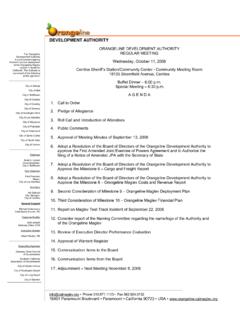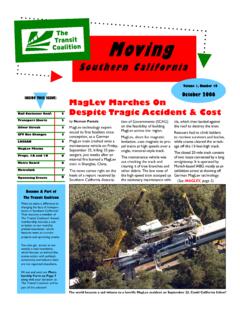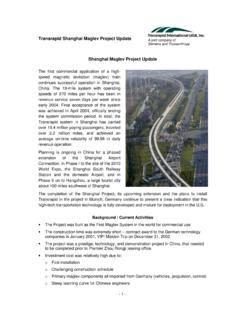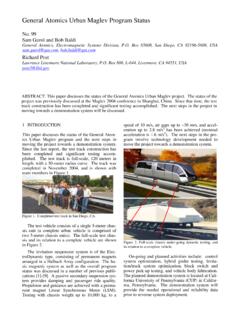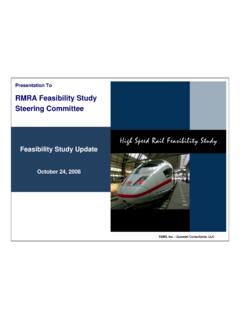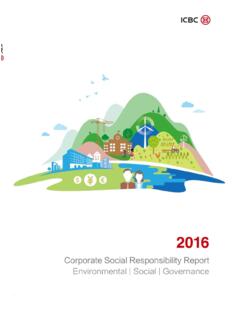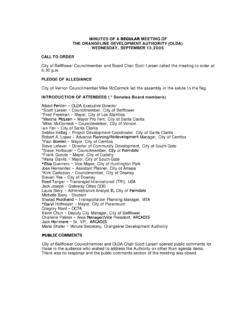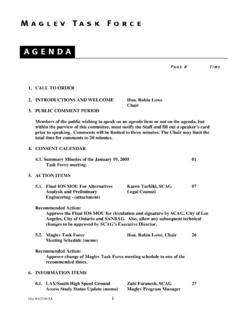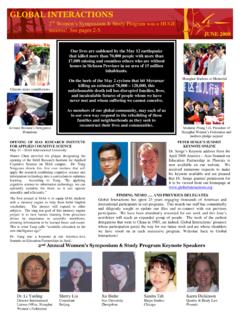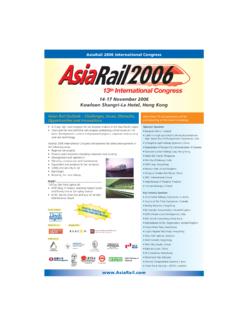Transcription of S L ConferenCe - slcatlanta.org
1 Southern LegiSLative ConferenCeofthe CounCiL of State governmentSSujit M. CanagaRetna Senior Fiscal Analyst and Staff Liaison to the SLC Economic Development, Transportation and Cultural Affairs CommitteeJuly 2009 The world s first high-speed train service Japan s Tokaido Shinkansen, connecting Tokyo, Nagoya, Kyoto and Osaka was inaugurated in 1964; in subsequent decades, the service has been expanded significantly to include trains that reach speeds up to 186 miles per hour. Spain s Alta Velocidad Espa ola (AVE) high-speed train service began in 1992, linking Madrid and Seville; in the past 15 years the AVE network has expand-ed to nearly 1,250 miles across Spain from Malaga in the south to Barcelona in the northeast.
2 In a similar vein, Ger-many s high-speed trains, the InterCityExpress (ICE), criss-cross the country at speeds up to 155 miles per hour while France s Train Grande Vitesse (TGV) trains connect cit-ies across France and adjacent countries at record speeds.* On January 1, 2004, the shanghai maglev Train, the world s first commercial high-speed maglev train, began ferrying passengers between shanghai s international airport and nearby Pudong (the eastern part of shanghai ) at speeds ap-proaching 268 miles per hour.
3 **Even as high-speed rail advanced tremendously in parts of Asia and Europe, rail travel in the United States has lan-guished as the American love affair with the automobile, the impressive interstate highway system and affordable air travel ensured that America s rail system did not prog-ress into the 21st century. However, this scenario is in the process of undergoing a radical transformation as a result of efforts initiated by the Obama Administration to include $13 billion ($8 billion in the 2009 American Recovery and Reinvestment Act (ARRA) along with an additional $5 bil-lion spread over the next five years) as seed money to fund up to 11 high-speed rail corridors connecting densely popu-lated areas of the country.
4 On June 17, 2009, the Adminis-tration released guidelines for states and regions to apply for federal funds under the ARRA with deadlines of July 10, 2009 (pre-application), and August 24, 2009 (final applica-tion). Federal officials noted that projects with established revenue sources and multistate cooperation efforts already identified would be front runners to secure federal funding. Based on these federal initiatives, it now is possible to envis-age a range of positive outcomes as a result of this renewed focus on 21st century rail travel in the United States.
5 For in-stance, focusing on the more populated areas of the country will ensure greater efficiencies as people (and some goods) move more quickly between the nation s major population centers. Reducing the number of vehicles from the nation s highways will reduce congestion while lowering the emis-sion of carbon monoxide into the environment, along with reducing air pollution and our dependence on imported oil. Finally, the research and development, construction and subsequent maintenance of these high-speed rail systems will lead to a host of direct and indirect economic benefits that will spur economic growth in the relevant cities and ad-jacent details on the new federal proposals continue to emerge, it is apparent that two types of projects would re-ceive funding.
6 (1) new, dedicated corridors for high-speed trains that proceed at speeds exceeding 200 miles per hour along the lines of those available in Europe and Japan and (2) enhancing and upgrading existing rail lines to permit faster train travel at speeds of up to 110 miles per hour. Notwithstanding these new federal proposals and the tre-mendous degree of interest reaching all the way to Presi-dent Obama, analysts have cited the current level of federal funding as only a down payment on a much more expensive proposition if the Administration s plans are to be fully real-* In April 2007, a TGV test train set the record for the fastest wheeled train in history, reaching 357 miles per hour.
7 ** maglev is a system of transportation that deploys a large number of magnets to lift, suspend, guide and propel vehicles, predominantly trains, using magnetic For example, experts point to the fact that if the entire rail system was retrofitted to accommodate consistent train speeds of up to 110 miles per hour (considered mod-erate speed ), the cost would rise to about $50 billion; if the system was built to accommodate speeds of up to 200 miles per hour ( high-speed ), the estimated cost leaps to $500 billion.
8 Experts also note the construction time pe-riod that would entail introducing a 21st century rail system in the United States, conservatively estimated as a decade from start to finish. Nevertheless, there is a great deal of enthusiasm percolating in a number of states regarding the improved potential for high-speed rail, particularly in states that had been pursuing this transportation mode for some decades now but were held back due to lack of funding, pub-lic support and federal evident in the map, the Obama Administration has des-ignated high-speed rail corridors linking the most densely populated areas of the country covering the Pacific North-west, California, South Central.
9 Gulf Coast, Florida, South-east, Chicago Hub, Keystone, Empire, Northeast and North-ern New before the recent federal forays into the high-speed rail arena, a number of states had initiated their own pro-grams. Some of these state programs go back several de-cades and include several SLC states. For instance, trans-portation and elected officials in Alabama, Louisiana and Mississippi coalesced to form the Southern High-Speed Rail Commission to promote passenger rail transportation on a regional basis some two decades ago.
10 The Commission has been energized in recent months, with the enthusiasm for high-speed rail radiating from the federal government, and is in the process of gathering economic impact data to demonstrate the viability of a high-speed train from New Orleans through Birmingham to Atlanta. Experts indicate that such a service would generate an economic impact of between $3 billion and $5 billion. In Alabama, Representa-tive Rod Scott has introduced a bill authorizing the Alabama Department of Economic and Community Affairs and the Southern High-Speed Rail Commission to develop a state rail plan and recommend is another SLC state that has a long history in pur-suing high-speed rail.

